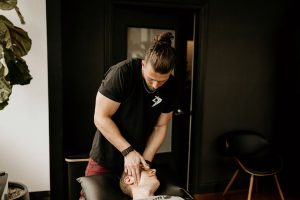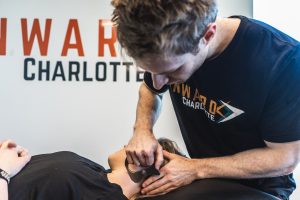
Manual therapy has proven to be an effective tool in treating TMJ Disorders in physical therapists. Learn more about how the team at Onward Physical Therapy helps to reduce pain from TMJ, and the role that manual therapy plays.
What is manual therapy?
Manual therapy is any ‘hands-on’ technique used to help with pain. This technique can include one, or several, of the following: soft tissue massage, joint mobilization, joint manipulation, tool assisted massage, and/or dry needling. These are all tools to help ease pain symptoms, so you can move better and more freely. These can be directed towards your TMJ (temporomandibular joint) and/or your cervical spine (aka your neck) to help with TMJ disorder.
What are common TMJ disorders?
Bruxism or teeth grinding is a very common TMJ disorder which causes the muscles around the jaw to feel tight. Soft tissue techniques like massage, tool assisted massage, and/or dry needling to the TMJ muscles and education on parafunctional habits (like avoiding/limiting pen biting, nail biting, ice chewing etc…) are very helpful to alleviate this.
Popping and clicking are also very common symptoms of TMJ disorder, and it is often a result of hypermobility (or extra movement) of the jaw on one side of the jaw and hypomobility (reduced movement) on the other. Both of these conditions can limit chewing ability and jaw opening. This requires TMJ manual therapy PLUS exercise to help fine tune jaw opening.
These common conditions may or may not be paired with headaches or limited cervical range of motion, so the neck will often also be addressed in your TMJ disorder care via manual therapy techniques.
How is manual therapy used for treating TMJ?
Muscles surrounding the jaw, head, and neck can all benefit from soft tissue massage, joint mobilization, joint manipulation, tool assisted massage, and/or dry needling. After an initial evaluation
with a physical therapist, the appropriate type of TMJ manual therapy and any other regions that need to be addressed (head and neck manual therapy may also be appropriate) will be recommended and decided between you and your physical therapist.
Benefits of Manual Therapy in Treating TMJ
Manual therapy plus exercise for TMJ disorder always demonstrates improved function for patients. Either intervention alone is not as potent; it is the #ANDnotOR combination of both treatments that alleviates pain associated with eating, talking, kissing, or jaw opening. Manual therapy for TMJ will be used in combination with exercise and education.
Is Manual Therapy for TMJ Painful?
TMJ manual therapy is a tool to calm pain and reduce any muscle tightness or joint stiffness, so the majority of the time it is not a painful stimulus but a pain relieving In the higher irritability stages, manual therapy will be chosen that is not provocative (i.e. does not cause increase in symptoms) and may be directed in other areas, such as your neck, rather than directly at or in your jaw.
As irritability and pain in your TMJ reduce, some techniques may be used and chosen that cause mild discomfort, like a “hurts so good” sensation. This mild discomfort will yield improved jaw opening and eating/chewing performance, and will be paired with a home exercise program to help ameliorate any pain and continue to improve opening and chewing tasks.
How Manual Therapy Differs from Joint Manipulation
Manual therapy does not always include joint manipulation for your TMJ disorder. It often involves soft tissue techniques like massage, instrument assisted massage, and/or dry needling directed to the muscles around your face, head, and neck. Manual Therapy for TMJ can also include joint mobilization inside your jaw, which involves moving the TMJ to access more movement in jaw opening. Soft tissue and mobilization techniques can be used not only at the jaw, but also directed to the neck to improve jaw opening. All TMJ manual therapy techniques will be chosen based on your individual preferences and do not automatically include joint manipulation.
Interested in meeting with one of our physical therapists to see if we’re the right fit? Find your nearest location here!
Recent Articles
Why Early Intervention Physical Therapy Accelerates Your Recovery

What to Expect at Your First Physical Therapy Session?

How to Choose a Physical Therapist

The Top 5 Misconceptions About Physical Therapy

The Complete Guide to Physical Therapy



